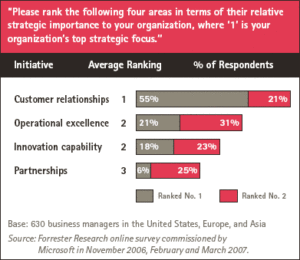What Drives Good Customer Service
Attracting, developing, sustaining, and retaining customers is the key to profitability.
In the world of customer service, we seem to be saying one thing and doing something different. We don’t walk our talk. But we are not alone as a group of service providers who are interested in what our customers need and want. This has become an epidemic in industries worldwide.
Microsoft commissioned a major survey back in 2007 as well. Its conclusion was that the number one business issue for service providers was “customer relationships.”
The survey noted: “They value innovations that support improvement in the customer experience, and they paint a picture of corporate cultures that prioritize customers.”
The survey conclusion also asked, “Why is it that their actions don’t support this belief?”
This is a similar conclusion that I reach in my consulting business. When intellectually we know what needs to be done, why is it we just don’t get it done?

This might be a cute comment, were it not so serious. The world has clearly changed. Products are much more capable and technology is definitely influencing how they can be used. The opportunities for clients to obtain products and services from a variety of suppliers have never been so numerous. How will we defend ourselves and protect our customers from competition?
We have a serious need to provide much better training, technology, and tools to our employees, especially the ones we charge with the responsibility of satisfying customers in the parts and service groups. Without good system information, these critical employees are dead in the water.
And so far, we haven’t provided them with much good information. Many times the first question we have to ask the customer in parts support or service inquiries is, “Who are you?”
How friendly is that opening for a discussion with a potential consumer? Does it bolster a “customer relationship”? I think not. Go back to the conclusion from the Microsoft survey and note the “innovations that support improvement in the customer experience.” What have you done over the past year to enhance the customer experience in your business? More importantly, what are you planning now?
My suspicion is there was nothing in the plan last year and this is not a subject included in many of your businesses’ annual planning cycles. You know that process, don’t you?When you set budgets and create forecasts. This planning cycle needs to be focused on the customer experience, not only on your profit and loss. Companies that focus inwardly are destined to fail. It is the company that focuses on keeping their customers happy that will succeed.
Let’s look at the top focuses of the companies surveyed in the Microsoft survey.
It is very clear and straightforward to me, and I am sure to you as well. The view of the market in 2009 is cloudy and mixed at best. We might have a somewhat brighter outlook based on the more environmentally sensitive mood in the country, but the economic outlook is much more difficult than at any other time in my experience.
Yet I know that parts and service business opportunities will increase. I also know that you know your opportunity to increase business in the parts and service area is huge. But I also think it is clear you either don’t know what to do or don’t want to do it. That is a difficult position to be in, isn’t it? The customer expects us to provide leadership to them. They expect us to provide the support they require for their needs.
So do yourself and your customers a favor and ask what they want you to do for them. Don’t be shy. They will willingly tell you what it is they want and need. But be careful. If you ask and they tell you, then you will have to act. If you don’t act, you will be in more trouble than if you hadn’t asked at all.
Last month we looked at your most valuable service attribute as a business—your employees. This month we’ve looked at retaining your customers, the people who provide everything in your life.
Are you ready for the challenge? The market, your employees, and your customers wait for your answer.

